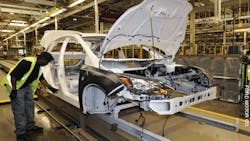Managing Health: Ergonomics - Is It the Answer to Productivity Challenges?
The most important and the truly unique contribution of management in the 20th century was a 50-fold increase in the productivity of manufacturing workers, said author and management consultant Peter Drucker, and "the most important contribution management needs to make in the 21st century is to similarly increase the productivity of knowledge workers."
What Drucker describes is the greatest challenge facing management today. It is astounding that most employers have no idea how much productivity they are losing or why. This raises the obvious questions: How can you measure productivity loss in an office environment and how do you prevent it?
The answer lies in ergonomics. It is the primary role of the ergonomist to help management identify and correct the factors which impede worker performance or put them at risk of occupational-related injuries and ailments.
Cost Components and Potential Savings
When you hire employees, you need to provide them with a place to work, furniture, equipment, supplies, software and support. The sum of these costs – direct employee costs related to recruitment and training, facilities costs (space, including common areas and operating costs) and IT costs (data and communications equipment, software, operating costs and support) – is the real cost per employee. Based on human resources costs of $70,000, facilities costs of $8,000 and IT costs of $2,000, the total cost per employee would be $80,000 per year. This means every employee who leaves and the position remains vacant, or for every position that is not filled despite increased demand, saves the employer $80,000.
Human resources obviously is the largest organizational cost and productivity is the key metric. This does not mean that offices should become sweatshops with managers timing all aspects of the job. What it means is that there are preventable and/or correctable conditions in every office that significantly impede worker productivity.
Identify and Improve Conditions
So how do we identify and improve these conditions? First, we must accept the premise that if you can't measure it, you can't manage it. If something is not consistently and continuously measured, there is no way to accurately understand the impact that it has on your organization.
First, identify what needs to be measured and then how to measure it. Once you've measured it, analyze it and determine what improvements need to be made. Once you've implemented improvements, follow up on the progress and continue again with further measurement and analysis.
Conduct an employee survey that identifies factors that impede productivity. Next, conduct a gap assessment to measure the gap between current levels of performance and risk, and potential. When you plug in your costs related to loss of income from productivity issues or employee injuries and those associated with making ergonomic improvements, you can determine the overall impact on the bottom line. This also will provide the information required to determine what improvements should be made and what measures should be considered for the most value to the employee and to the comany.
Finally, a pilot program, involving a small group representative of your employee population, can be used to prove the impact of any proposed measure before implementation and required investment. The initial pilot program provides each employee with their individual assessment, based on the information they provided in the gap assessment, as well as recommendations and instructions on how to correct and avoid conditions causing them discomfort and impeding their performance. The impact of changes on improved productivity and lower workers' compensation costs becomes the ROI analysis required by management prior to any capital investment.
Subscribe to EHS Today Magazine to receive leading coverage of the EHS industry.
Hank Austin, CSP, is an ergonomist with an M.S. in ergonomics from Texas A&M University. He is an Ergo Squad consultant based in San Antonio, Texas. He was in charge of ergonomics for a Fortune 200 company for 15 years, served 3 years as the executive director of the Office Ergonomics Research Committee and was the chairman of the Texas A&M University/National Science Foundation Center for Ergonomics.
